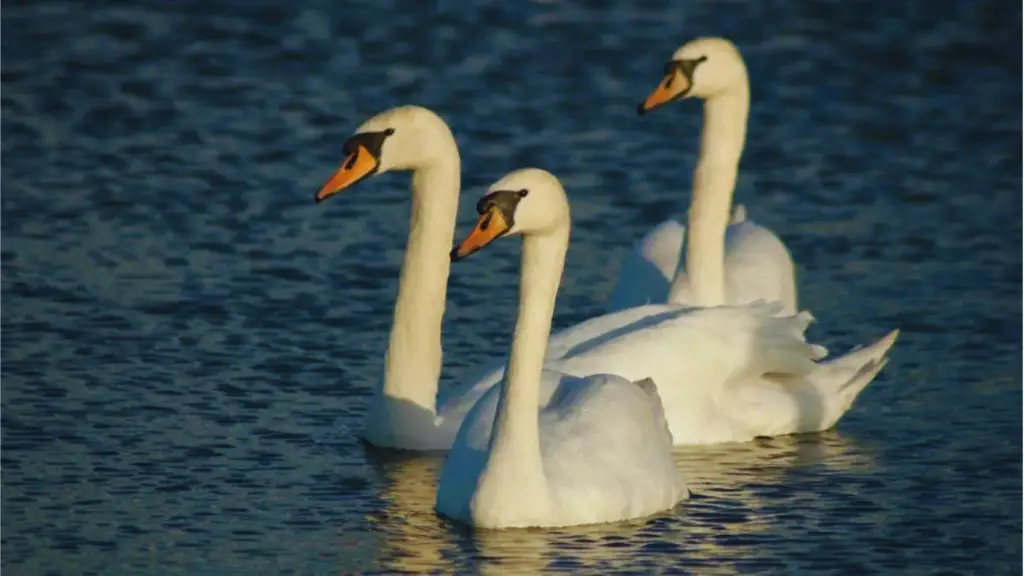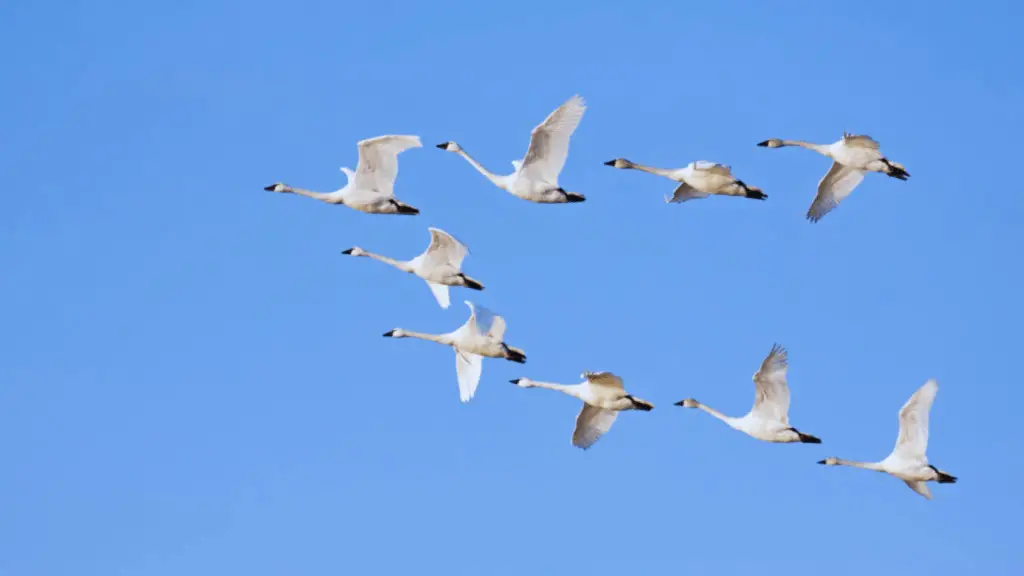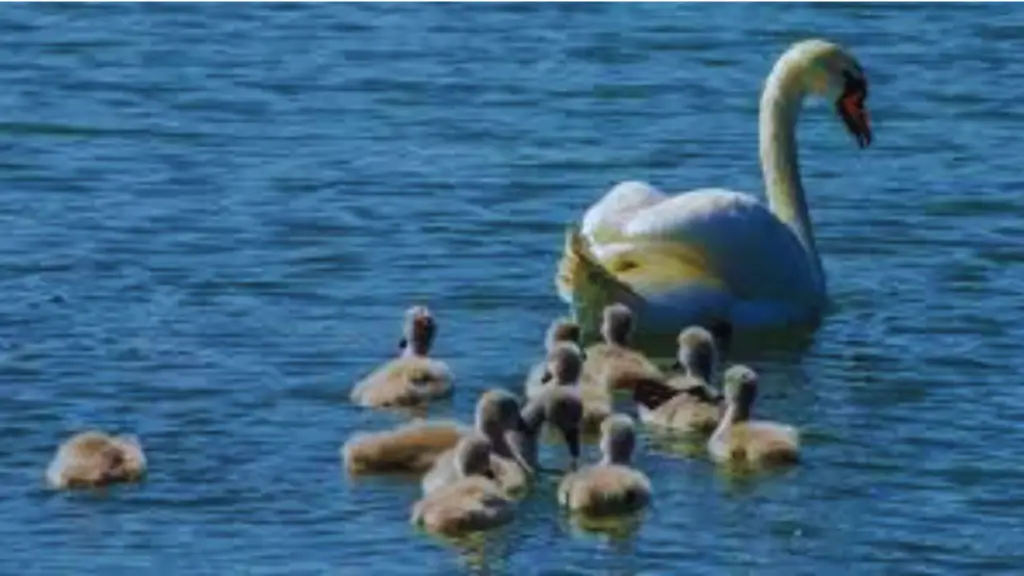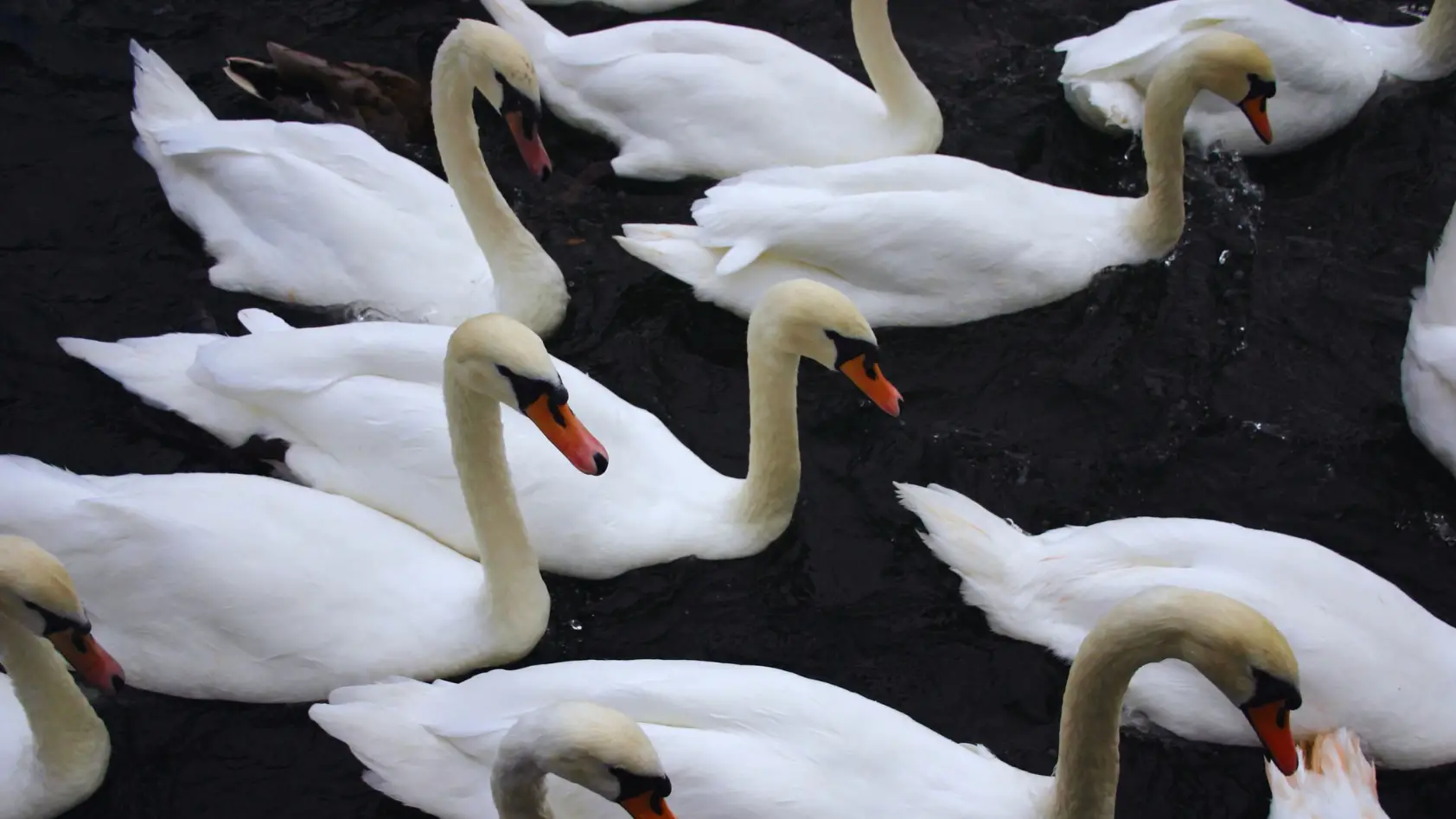If you’re wondering what is a group of swans called, our expert guide has all the information you need. Discover the proper terminology used to describe different groups of swans, including cob, pen, and cygnet. Learn about the behaviors and characteristics of these graceful birds and how they interact with each other in groups.
Step into the enchanting world of swans and revel in their graceful charm. These majestic creatures exude elegance with their long necks, pristine white feathers, and delicate movements.
But there is more to swans than meets the eye. Dive deep into their world and discover the intricate social structure and fascinating behaviors that define their lives.
However, swans face numerous challenges in the form of habitat loss and human interference. Thankfully, there are dedicated organizations working tirelessly to conserve these magnificent birds and protect their populations.
So join us on this journey as we explore the captivating realm of swans and come to appreciate the importance of preserving their graceful presence in our world.
Key Takeaways
- Swans are large water birds known for their long necks, slender bodies, and white feathers.
- They form strong bonds with their mates for life and exhibit synchronized courtship displays.
- Swans communicate using vocalizations and fiercely defend their nests and young.
- They possess elegance in motion, swim together in a synchronized manner, and have the ability to mate for life, showcasing remarkable loyalty and commitment.
An Introduction to Swans
Are you ready to learn about the majestic world of swans? These beautiful creatures are known for their elegance and grace, captivating the hearts of many. Swans are large water birds that belong to the Anatidae family, which also includes ducks and geese. They are recognized for their long necks, slender bodies, and stunning white feathers.
One of the most fascinating facts about swans is their ability to form strong bonds with their mates. Once a pair finds each other, they stay together for life, creating a deep and lasting connection. This bond is not only exhibited through their constant companionship but also in their synchronized movements during courtship displays.
Another remarkable characteristic of swans is their distinctive way of communication. They use a variety of vocalizations, including honks, whistles, and hisses, to express their emotions and convey messages to other swans. These sounds can be heard echoing across lakes and rivers, adding to the enchantment of their presence.
In addition to their elegance and communication skills, swans are also known for their protective nature. They will fiercely defend their nests and young against any potential threats, showing great devotion and care for their offspring.
So, immerse yourself in the world of swans and revel in their graceful charm. Witness their majestic beauty and marvel at the wonders of nature they represent.
The Graceful Appearance of Swans
Immerse yourself in the ethereal beauty of these majestic creatures, as they glide effortlessly across the water. The graceful appearance of swans is truly captivating. Here are three aspects of their charm that will leave you in awe:
- Elegance in motion: Watch as swans gracefully move through the water, their long necks curving in perfect symmetry. Their white feathers glisten under the sunlight, creating a striking contrast against the calm blue surface.
- Feathered finery: Swans possess a regal air, and their plumage only adds to their allure. Their feathers are immaculate, creating a pristine white canvas that is both soft and velvety to the touch. As they preen themselves, each feather falls perfectly into place, enhancing their already exquisite appearance.
- Serene demeanor: Swans exude a sense of tranquility that is simply mesmerizing. Whether they are gliding across a serene lake or gracefully resting on the edge of a pond, their calm and composed demeanor is a sight to behold. Their gentle movements and serene expressions make them seem like ethereal beings from another world.
Witnessing the graceful appearance of swans is a truly enchanting experience. So, take a moment to revel in their charm and allow yourself to be captivated by their elegance.
Exploring the World of Swans
Delve into the enchanting realm of swans and discover the ethereal beauty that lies within. Swans are magnificent creatures that captivate the hearts of those who observe them. With their long, graceful necks and elegant white plumage, swans exude an air of serenity and charm. But there is more to these majestic birds than meets the eye.
Swans are not only known for their beauty, but also for their strong sense of family and community. These birds form tight-knit groups called ‘bevy’ or ‘wedge’ of swans. Within these groups, they often swim together in a synchronized manner, creating a mesmerizing sight. The bond between swans is evident in their devotion to their partners and their fierce protection of their offspring.
Another fascinating aspect of swans is their ability to mate for life. Once a pair has formed a bond, they stay together for the rest of their lives, which can span up to 20 years. This loyalty and commitment are truly remarkable and add to the allure of swans.
Observing swans in their natural habitat is a truly magical experience. Whether they are gracefully gliding across a tranquil lake or engaging in a courtship dance, swans never fail to leave a lasting impression. So take a moment to revel in the graceful charm of swans and immerse yourself in their captivating world.
The Unique Collective Noun for a Group of Swans

Witness the enchanting connection that exists within a bevy or wedge of these majestic creatures, as they gracefully glide across the water in perfect synchronization. The unique collective noun for a group of swans is indeed a sight to behold.
Imagine yourself standing by a serene lake, watching as a bevy of swans gracefully swim together. Their white feathers glistening in the sunlight, their long necks elegantly stretched out, and their powerful wings propelling them effortlessly through the water.
As you observe this mesmerizing display, you can’t help but feel a sense of awe and admiration for these beautiful creatures. Each swan moves with such grace and poise, yet they remain connected to one another, moving as a cohesive unit. It’s as if they are communicating through their synchronized movements, creating a seamless ballet on the water’s surface.
Being a part of a bevy or wedge allows swans to find safety and companionship. They rely on each other for protection, especially during their nesting season. By sticking together, they can ward off potential threats and ensure the survival of their young. Their collective presence is not only visually stunning but also serves a practical purpose in their survival.
So, next time you come across a group of swans, take a moment to revel in the graceful charm they possess. Witness their synchronized movements and marvel at the enchanting connection that exists within a bevy or wedge of these majestic creatures. It’s a sight that will leave you in awe of nature’s wonders.
Swan Behavior and Social Structure
Step into the world of swans and discover their fascinating behavior and intricate social structure. Have you ever wondered how these majestic creatures communicate and interact with each other? Well, let me enlighten you.
- Communication: Swans have a variety of ways to convey their messages. They use a combination of vocalizations, body movements, and even their wings to communicate with their flock. Whether it’s a gentle hiss to establish dominance or a loud honk to warn of danger, their communication is both powerful and effective.
- Pair Bonding: Swans are known for their strong pair bonds. Once they find their mate, they stay together for life. They engage in a beautiful courtship display, where they mirror each other’s movements and create heart-shaped formations on the water. This bond helps them protect their territory and raise their young.
- Family Life: Swans are devoted parents. They build large nests made of reeds and twigs, usually near water. Both the male and female take turns incubating the eggs, and once the cygnets hatch, they are fiercely protected by their parents. This family unit stays together until the young swans are old enough to start their own families.
- Flock Dynamics: Swans are highly social creatures and often form large flocks. These flocks provide safety in numbers and allow them to share resources. Within the flock, there is a hierarchical structure, with dominant individuals leading the way. They work together to find food, navigate their environment, and ensure the overall well-being of the group.
So, next time you see a group of swans gracefully gliding across the water, remember the intricate social structure and fascinating behavior behind their elegance.
Swan Communication and Vocalizations
Let’s explore how swans use their unique vocalizations to communicate with each other and convey important messages. Swans are known for their elegant appearance and graceful movements, but their communication skills are equally impressive. They use a variety of vocalizations to express their emotions and establish their presence in their environment.
Swans have a wide range of vocalizations, each serving a different purpose. The most common sound they make is a soft honking noise, which is often used to greet other swans or signal their location. They also have a distinct hissing sound, which they use to warn off potential threats or display aggression. In addition to these sounds, swans can also produce a variety of whistles, grunts, and trumpeting calls to communicate with their flock.
To help you visualize the emotional impact of swan vocalizations, I have created a table below. This table showcases the different vocalizations and their corresponding emotional responses. By understanding the meaning behind these sounds, you can better appreciate the complexity of swan communication and the depth of their emotional lives.
| Vocalization | Emotional Response |
|---|---|
| Soft honking | Greeting and warmth |
| Hissing | Warning and defense |
| Whistles | Excitement and joy |
| Grunts | Contentment and relaxation |
| Trumpeting | Alarm and distress |
So the next time you see a group of swans gracefully gliding across the water, take a moment to listen to their vocalizations. You might be surprised by the range of emotions they can convey and the intricate communication network they have established within their flock.
Swan Migration Patterns
As you watch the swans migrate across vast distances, you’ll be amazed at how they navigate using an internal compass, much like sailors relying on the stars to guide their way through the open sea. These majestic birds possess an incredible ability to sense the Earth’s magnetic field, allowing them to determine their direction and stay on course during their long journeys.
Swans are known for their annual migration patterns, which vary depending on their geographical location. In North America, the Trumpeter Swan and Tundra Swan undertake impressive migrations, traveling from their breeding grounds in the northern regions to more temperate areas in the south. They cover thousands of miles, crossing borders and encountering diverse landscapes along the way.
During migration, swans fly in V-shaped formations, taking advantage of the aerodynamic benefits of this pattern. This formation allows them to conserve energy by taking turns leading the way and reducing wind resistance for those flying behind. It’s a remarkable sight to witness, as the swans gracefully glide through the sky, their wings beating in perfect harmony.
Swan migration is not only a physical journey but also a time for social interaction and strengthening bonds. These migratory flights provide opportunities for swans to form new partnerships and reinforce existing ones. The journey is a testament to their resilience, adaptability, and the inherent beauty of their natural instincts.
So, as you observe the swans on their migratory path, take a moment to revel in the sheer grace and elegance of these magnificent creatures. They embody the spirit of exploration and remind us of the wonders that await us in the natural world.
Swan Conservation and Threats
As you marveled at the incredible journey of swan migration patterns, it’s time to delve into an equally important aspect: swan conservation and threats. Now, let’s take a closer look at what measures are being taken to protect these majestic creatures.
Swans, with their elegant grace, are facing numerous challenges in their habitats. One of the primary threats is habitat loss due to urban development and pollution. The destruction of wetlands and water bodies disrupts their natural breeding and nesting grounds. Additionally, the increasing pollution levels in waterways pose serious health risks to these birds.
To safeguard these remarkable creatures, conservation efforts are being undertaken worldwide. Organizations are actively working to restore and protect wetlands, ensuring a safe haven for swans and other wildlife. The implementation of strict regulations on pollution control is also crucial in maintaining the swans’ well-being.
To illustrate the significance of swan conservation, let’s take a closer look at this 2-column, 4-row table:
| Threats | Conservation Actions |
|---|---|
| Habitat Loss | Wetland Restoration |
| Pollution | Pollution Control |
| Hunting | Wildlife Protection |
| Global Warming | Climate Change Mitigation |
By recognizing these threats and taking appropriate action, we can ensure that future generations can revel in the graceful charm of swans.
Swan Conservation Efforts and Organizations
Conservation organizations globally are actively working towards protecting swans by implementing various measures such as wetland restoration, pollution control, wildlife protection, and climate change mitigation. These efforts aim to ensure the survival and well-being of swans in their natural habitats.
- Wetland Restoration: Conservation organizations recognize the importance of wetlands as crucial habitats for swans. They work towards restoring and preserving these wetlands, creating suitable environments for swans to breed, feed, and thrive.
- Pollution Control: Swans are highly sensitive to pollution, which can negatively impact their health and reproductive success. Conservation organizations actively monitor and control pollution levels in swan habitats, ensuring cleaner water and reducing the risks posed by pollutants.
- Wildlife Protection: Conservation organizations play a vital role in protecting swans from poaching, illegal hunting, and other human-related threats. They collaborate with local authorities and communities to enforce strict regulations and promote responsible behavior towards these majestic birds.
By actively engaging in these conservation efforts, organizations are actively contributing to the preservation of swan populations and their unique ecological roles. It is through their dedication and collective actions that we can revel in the graceful charm of swans for generations to come.
The Importance of Protecting Swan Populations

Preserving the populations of these elegant creatures is of utmost importance in maintaining the delicate balance of our ecosystems. Swans play a crucial role in their habitats, contributing to the health and diversity of our natural world. By protecting swan populations, we are not only ensuring the survival of a magnificent species but also safeguarding the overall well-being of our environment.
Let’s take a closer look at the reasons why preserving swan populations is so essential:
- Ecological Balance: Swans help maintain the equilibrium of their ecosystems by controlling aquatic vegetation. Their feeding habits prevent the excessive growth of plants, ensuring a healthy balance for other species to thrive.
- Biodiversity: Swans are an integral part of our natural heritage. Their presence enhances the diversity of wildlife, creating a harmonious and vibrant ecosystem.
- Indicator Species: Swan populations serve as indicators of the overall health of their habitats. By monitoring their numbers and behaviors, conservationists can assess the well-being of water bodies and take necessary actions to protect them.
Preserving swans not only benefits these captivating creatures but also contributes to the preservation of our entire ecosystem. Let us all come together to ensure their survival for generations to come.
Conclusion: Appreciating the Graceful Charm of Swans

Take a moment to appreciate the elegance and beauty of these magnificent creatures, and let their graceful presence inspire a deep sense of wonder and awe. Swans, with their long, slender necks and pure white feathers, are truly a sight to behold. As they glide effortlessly across the water, their movements are a true testament to their grace and poise.
One cannot help but be captivated by the sight of a group of swans, known as a ‘revel,’ gracefully swimming together in perfect harmony. Their synchronized movements and gentle demeanor create a sense of tranquility and serenity. It is as if time stands still when in the presence of these majestic creatures.
Swans have long been associated with beauty, love, and purity. Their elegant appearance and gentle nature have inspired countless artists, poets, and musicians throughout the ages. They symbolize grace and elegance, and their presence evokes a sense of peace and calmness.
As we revel in the graceful charm of swans, let us also remember the importance of protecting their populations. These stunning creatures are vulnerable to habitat loss, pollution, and hunting. It is our responsibility to ensure their conservation, so future generations can continue to appreciate their beauty and magnificence.
In conclusion, swans are truly remarkable creatures that deserve our admiration and respect. Their elegance and grace are a reminder of the beauty that exists in the natural world. So, take a moment to appreciate the presence of swans, and let their beauty inspire you to protect and preserve the wonders of nature.
What Is a Group of Swans Called: FAQs
How long do swans typically live?
Swans typically live for about 10 to 20 years in the wild. However, with proper care and protection, they can live up to 30 years or even longer.
What is the average wingspan of a swan?
The average wingspan of a swan is about 7 feet. It is impressive to see them soaring through the sky, their majestic wings outstretched, showcasing their elegance and grace.
Are swans aggressive towards humans?
Swans, known for their graceful charm, can be aggressive towards humans, especially during nesting season. It’s important to maintain a safe distance and avoid provoking them, as they have powerful wings and can cause harm.
Do swans mate for life?
Swans mate for life. Their strong bond is formed through elaborate courtship rituals. They are known for their loyalty and devotion to their partners, creating a beautiful and lasting relationship.
How do swans defend themselves against predators?
Swans have a fascinating defense mechanism. Did you know that they can break a human’s bones with just one swing of their powerful wings? This is how they protect themselves against predators.
Conclusion
As you’ve delved into the intriguing world of swans, you’ve discovered their mesmerizing grace and beauty. From their elegant appearance to their unique collective noun, swans have captivated your imagination.
But there is more to these magnificent creatures than meets the eye. With conservation efforts and organizations dedicated to their protection, the fate of swans hangs in the balance. Will we rise to the challenge and safeguard their existence? Only time will tell.
In the meantime, let us revel in the graceful charm of swans, cherishing their presence while we still can.













